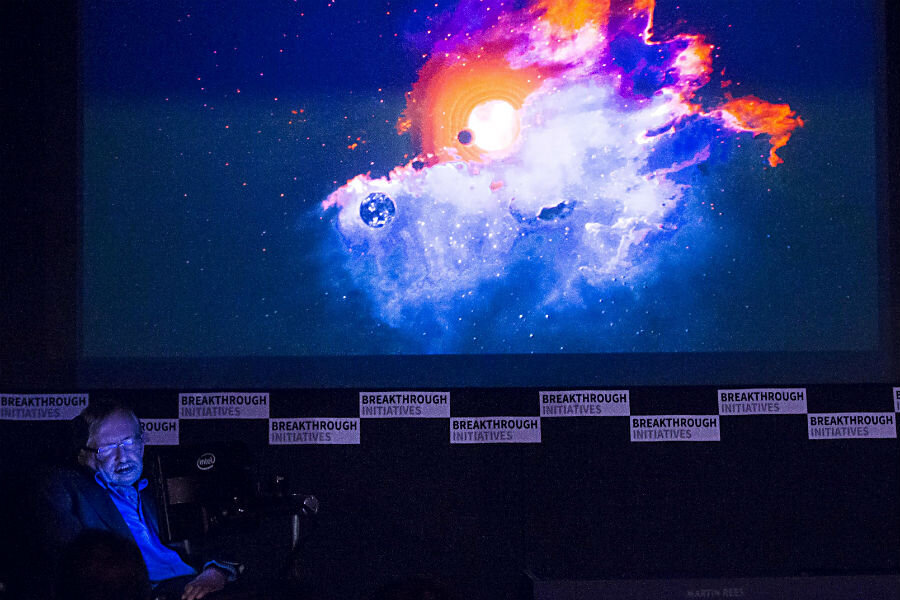Is Stephen Hawking's latest black hole theory full of holes?
Loading...
Stephen Hawking announced Monday that there is hope to be found in the darkness of black holes, triggering headlines. But the Hawking pronouncement is being dismissed by some physicists as merely a capitulation to established string theory – and as needing more detail to be understood.
“If you feel you are in a black hole, don’t give up,” Dr. Hawking said to an audience at a public lecture in Stockholm, Sweden, on Monday. “There’s a way out.”
Talking about finding hope in the cosmos may go over big with an audience of laymen, but theoretical physicists need more than the notion that a light exists in the darkness – they insist on being told why, where, how and upon which surface it shines.
Black holes originate when massive stars collapse or “die” under their own gravity, creating a gravitational pull so intense, not even light can escape.
Hawking is revisiting the 40 year-old "black hole information paradox" debate of the early 1970s, says Alan Guth, the Victor F. Weisskopf Professor of Physics and the Margaret MacVicar Faculty Fellow at the Massachusetts Institute of Technology (MIT) in Cambridge.
“After Stephen Hawking invented Hawking Radiation, he initially thought that information was lost and they had this bet. Hawking, together with Kip Thorne had a bet with John Preskill, over this,” Professor Guth says in an interview.
“Hawking and Thorne both believed that information was lost in black holes, while Preskill thought that it was impossible. The information was never lost,” Guth explains. “John Preskill was going on the idea that quantum theory was correct and would not be violated by black holes.”
In Hawking's initial theory, according to Guth, a black hole would eventually evaporate, leaving nothing. This presented a conflict for quantum mechanics, which dictates that nothing, including information, can ever be lost. If black holes retained information forever in their singularities, there would be a fundamental flaw with quantum mechanics.
But Guth agrees with Hawking's latest statement of black hole theory. “So yes, I do think there is a good chance of this being valid,” Guth says. “Hawking later conceded the bet, saying he believed that information is returned a disguised state.”
Theoretical physicist Leonard Susskind put it this way: “There is no story. Or more correctly, there is a big story but it's not this one.”
“Stephen Hawking was a great physicist whose work on black holes in the 1970s set physics on a new course. He raised a profound question about the fate of information that falls into a black hole. The fact that he came down on the wrong side of the issue does not diminish the value of his deep insight or in any way weaken his legacy,” writes Dr. Susskind, director of the Stanford University Institute for Theoretical Physics, in an email interview.
“His recent observation that black holes are chaotic systems that absorb information and re-emit it from the horizon albeit in a very scrambled form, is hardly new," Susskind explains. "It is exactly what people like myself, Gerard 't Hooft, Don Page, John Preskill, Juan Maldacena, and by now many others have understood for more than two decades. It seems that Stephen has come around.”
Hawking also stated Monday, “I propose that the information is stored not on the interior of a black hole, as one might expect, but on the event horizon.”
Hawking is positing that a hologram – the storing of three dimensional information on a two dimensional surface – holds the information on the lip of a black hole.
What has his fellow theoretical physicists and cosmologists up in arms today is the question of what surface Hawking is talking about.
Samir Mathur, a professor of physics at Ohio State University in Columbus, Ohio, told the Monitor, “The crucial question is: Does the black hole have a hard surface on which the hologram can be written? Hawking does not seem to address this question.”
The leader in fuzzball theory continued, “A group of us working with string theory had shown that black holes are very different from what had been imagined: they are fuzzballs, which do have a hard surface at the horizon. We had then given a model by which a hologram could be written on this hard surface. But in his talk Hawking never mentions string theory or fuzzballs.”
“I am not sure what Hawking is saying: Is he trying to put an 'approximate hologram' on the vacuum? Then there would be a conflict with information theory,” Professor Mathur concludes. “If he is assuming that the black hole has a real surface on which the hologram is written, then he has to show how such a surface arises; and the only mechanism known for this is the fuzzball mechanism of string theory.”






